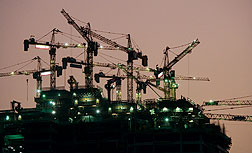 Michael Goodman/ENR |
When the public relations man for an emerging, multibillion-dollar real estate development concedes there are probably 10 schemes just as big within an hour’s drive, then you know you must be in Dubai. When complete, Dubai Festival City will have 70,000 residents in 20,000 homes and a daily population of over twice that number. At its site, by Dubai airport, nearly $4 billion of construction is now in hand, representing just a third of the total plan.
Over a large tract of desert, stretching south from the city, Dubai is building an entire tourism and leisure industry for a population many times bigger than that of the emirate’s 1.3 million people.
Just two of the many mega-developments will create over 60 major hotels in the next few years, the largest with 6,500 rooms. It will be the world’s biggest, a claim made for many of Dubai’s projects.
Next month, for instance, local Dubai Waterfront Co. expects to announce plans for a new city for 1.8 million people to be built over the next 15 years. The centerpiece is a proposed skyscraper, designed by New York City’s Pei Partnership, which could potentially reach a record-breaking height of 1,000 m and pass Burj Dubai, now under construction.
And then there are the countless malls, each bigger than the other, and all competing for attention. One developer boasts of its proximity to Dubai Creek, Dubai’s best natural amenity. Another, less well placed in the desert, offers a 400-meter-long ski slope with real snow. “What is going on here doesn’t seem real any- more,” says Middle East veteran Anthony Gordon, a project director with construction manager Turner International.
Facing dwindling oil reserves, Dubai’s rulers decided some years ago to create a global center of leisure and shopping. The very act of building necessary new facilities has helped the local economy grow, reportedly by 16% a year.
Until recently, Dubai was a medium-size city centered on Bur Dubai and Deira commercial districts, on either side of the creek’s mouth. The wide Sheikh Zayed highway headed southwest through mainly open desert, to Jebel Ali port, some 50 km along the coast, and on to Abu Dhabi, a couple of hours away.
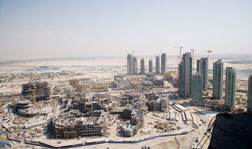 Michael Goodman/ENR Dubai "downtown" takes shape in shadows of new towers.
|
Now, the highway begins as an avenue of high-rise towers leading into an area of immense developments, including “the world’s biggest” theme park, along a band roughly 20 km wide. And because the coastline isn’t long enough for all the projects, four vast clusters of islands, big enough to house the current population, are being built.
 Askew
|
To those who wonder what underpins such frenetic investment, Tim Askew, Atkins Middle East managing director, explains that Dubai is a larger market than it seems. Including India, it is centered in a market of 1.5 billion people. For the “substantial middle class” in the region, Dubai is an attractive environment, he says. Its population is probably 60% Indian nationals, he adds.
“We are not seeing a bubble development in the same way as Southeast Asia where the...boom was bank-rolled by dollar loans that defaulted,” adds Askew. “In Dubai, it’s bankrolled with oil dollars.”
 |
 Michael Goodman/ENR Rapid development stretching along coast includes an indoor ski slope.
|
The market is red hot and construction and real estate executives expect no imminent downturn. “It’s not going to slow down drastically, but it will maybe stay at this peak for a few years,” says Abdo Kardous, the local senior vice president of Hill International Inc. Andrew Keegan, vice president for project management at the large private-sector Majid Al Futtaim Investments LLC, forecasts a “fairly hot” market for three to five years when oversupply of commercial and residential space will appear.
But with a new city of up to 300,000 people planned for Jebel Ali, along with its new airport, “I don’t think it will be a crash...there will still be a lot of construction,” says Keegan. Even when Dubai does slow, nearby Qatar and Abu Dhabi will take up the slack, believes Nigel Hayward, area director for Hyder Consulting Middle East Ltd.
Dubai’s boom is still relatively new, but “the market is now maturing,” says Sunil Gomes, vice president for development of government-owned developer Nakheel Properties. “Clients are requiring better buildings [and] that puts a lot of pressure on consultants.”
Among design firms in Dubai, the biggest have been in the region for decades, often working initially on infrastructure. With Dubai’s real estate boom, the smarter firms turned to building design in the 1990s.
With 80 architects among its 500 local staff, Atkins Middle East is one of the biggest local multidisciplinary design firms, now 10 times bigger than a decade ago. Its springboard was the sail-shaped, Burj Al Arab hotel, off Jumeirah beach.
 Hayward
|
Building design now accounts for just over half of Hyder’s workload, and half of that is on the super-high Burj Dubai, says Hayward. The firm’s first major local buildings, 10 years ago, were the two Emirates Towers, then the region’s tallest at up to 355 m. “It’s a big commitment to set up an office here,” says Hayward. “But being local is important.”
Clients are not averse to switching designers at the last minute. With structural design complete on Dubai Festival City’s $625-million mall two years ago, the owner changed architects. The new design required major structural revisions by Hyder, delaying its opening by months to next spring.
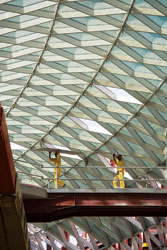 Michael Goodman/ENR Festival City's new roof encloses another of Dubai’s billion-dollar-plus developments in the desert.
|
International construction managers have also entered the market in recent years. Turner Construction is busy on several fronts, particularly on the Burj Dubai. Hill first set up in Abu Dhabi 20 years ago and expanded into Dubai, registering there five years ago.
Bovis Lend Lease International Ltd. has grown its local operation from 10 to 90 in two years. It has “a requirement to grow to 260 by the first quarter of next year with work we’ve got today,” says Mark Fletcher, regional CEO.
For construction services suppliers, Dubai is now a sellers’ market. Average construction costs in the UAE, of which Dubai is a member, have risen 16% annually in the last few years, with concrete and rebar rising 40 to 60%, says Gomes. Contractors “are turning away tenders. They don’t need the work,” he says. Nakheel has turned to more negotiated contracts, he adds.
Dubai Festival City’s developer increasingly is using design-build to save time, says Robert David, director of design and construction. “A lot of projects are running behind, he adds.
| + click to enlarge |
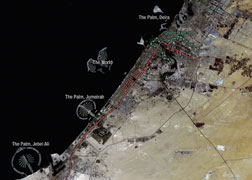 Nakheel |
International general contractors are in partnership with locals, says Rob Pickering, Hyder’s project director on Burj Dubai, where Korea’s Samsung Corp. is lead contractor. Contractors not already present appear to feel they are too late but foreign design firms are more bullish. Their need is reflected by dwindling bidding lists. “We are not seeing so many requests for competition where you are put up against six others,” he says.
Migrant labor, once abundant, is becoming elusive. Workers from the subcontinent, the lifeblood of Dubai’s boom, are now retained more by India’s own vibrant construction sector. “Some contractors are now starting to source labor out of China,” David says.
As well as reportedly absorbing over 25% of the world’s tower cranes, Dubai is greedy for migrant labor. About 20,000 people, for example, have worked on one island’s buildings alone.
“The work force is not as organized as in other parts of the world,” says David. “In the past 12 months, there have been a couple of workers’ demonstrations....They’ve been settled and I think there have been some improved conditions.”
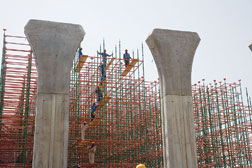 |
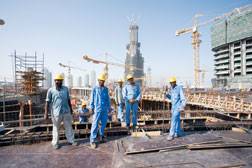 Michael Goodman/ENR New bridges will ease growing traffic congestion (above). Workers have been vocal in protesting working conditions, pay.
|
Recent new rules ensure four-hour breaks in the hottest summer months. Often hired on two-year contracts, workers have one day off a week. Living in construction camps, they earn little by Dubai’s western standards. A safety supervisor on one mega-project says he earns $220 a month and sends $190 home to Chennai.
While pay levels are relatively low, health and safety standards among international firms are high, says R. K. Moorthy, Turner’s safety manager on Burj Dubai. But, he reports one death at the tower job.
Life is better higher up the hierarchy. For construction professionals, Dubai “is the most exciting place to be in the world,” says Bovis’ Fletcher. With its tax advantages, salaries are considered good, but not at legendary levels of the region’s first oil boom.
Responsibility also comes quickly. “I've been a design manager on two towers,” says Mark Earley, a 32-year-old design engineer at Hyder Middle East. “I would not get projects like that in the U.K.”
But boomtown Dubai also presents hurdles. Increasing traffic congestion impairs the quality of life, though major planned investments will help. The municipality plans to increase the number of traffic lanes over Dubai Creek from 19 to 45 by 2008, easing pressure on the Al Maktoum Bridge.
By the end of this decade, the new metro will provide two lines in the commercial centers on either side of the creek and one following the coast along the development corridor. That also will shift Dubai’s center of gravity away from the congested city.
 Full Dubai Coverage
Full Dubai Coverage  Photographer Michael Goodman's view of a Middle East Boomtown
Photographer Michael Goodman's view of a Middle East Boomtown The People Behind the Boom
The People Behind the Boom 
Post a comment to this article
Report Abusive Comment